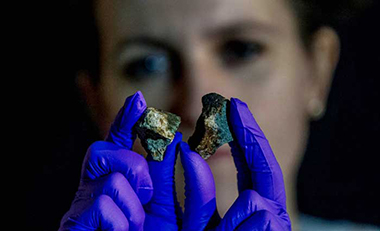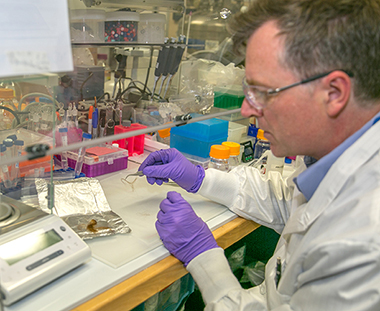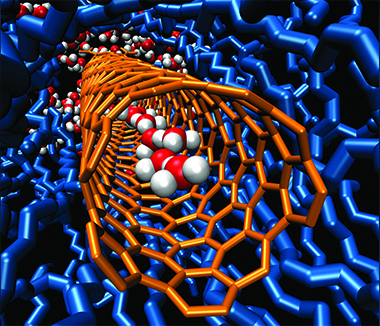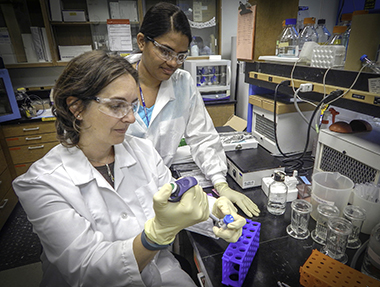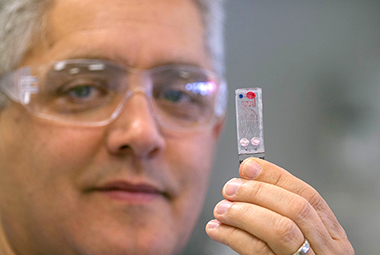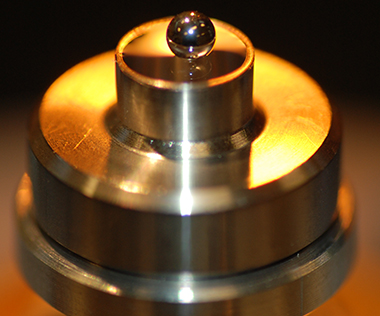Science and TechnologyExpanding the boundaries of scientific knowledge and advancing the technological state of the art to solve problems of national and global importance
Research applying Livermore’s multidisciplinary approach to problem solving and world-class experimental and computational resources leads to exciting discoveries and innovative advances that support mission needs.
Key Advances in Additive Manufacturing
New materials created at Livermore in FY 2016 by additive manufacturing (AM) are serving as fundamental building blocks of innovation. For example, researchers printed “living” blood vessels using a 3D printer and a bio-ink made of biocompatible materials. The printed cells and other biomaterials form tubes that deliver nutrients to a surrounding environment of printed cell tissue, and self-assembled capillaries deliver nutrients to the tissue. The printing process allows more effective reproduction of cell physiology for ex vivo human health research, such as LLNL’s human-on-a-chip project (see Human-on-a-Chip Monitors Live Neurons).
Livermore researchers also 3D-printed parts out of reactive materials, enabling them to exercise more control over the energy release rate of reactive composites, such as thermite nanoparticles. This development promises new reactive materials for applications that need bursts of energy, automotive air bags for example. In addition, researchers built multiple layers of lattices, ranging from nanometer- to centimeter-scale, to produce ultralightweight 3D flexible materials. With properties not found in nature, these materials could find use in applications like aircraft parts, flexible armor, and batteries. Other materials reported over the year include those that can fold and unfold over time (adding a fourth dimension to 3D materials) and ultralight supercapacitors for energy storage.
Laboratory researchers are also delving into the complex physics of 3D printing techniques to optimize material design for meeting functional needs and improving quality control, which is important for product certification. For example, through research in micro-scale interactions and material dynamics, they have discovered phenomena that better explain the causes of porosity in metal parts produced by the laser powder-bed fusion process, paving the way toward improvements in AM part performance.
A Focus on Asteroids
Astronomical objects, such as asteroids, provide insight into the origins of our solar system and are of keen interest to Laboratory scientists. However, they also threaten life on Earth. NASA has identified more than 14,000 asteroids crossing the vicinity of Earth’s orbit. Planetary defense researchers at Livermore have modeled the physics of deflecting an asteroid on a collision course with Earth through a high-energy impact. Research published in the past year used computer simulations to examine how asteroid shape, density, porosity, and rotation affect the strategy of deflection by kinetic impact and has provided options on how to design such missions. Livermore’s planetary defense team is also studying meteorites scavenged from Antarctica. These samples are vaporized by strong laser pulses in the Laboratory’s Jupiter Laser Facility to collect data about physical properties that are needed to design a high-impact deflection mission.
Researchers from LLNL and the Johns Hopkins University Applied Physics Laboratory are on the team selected to participate in one of two NASA Discovery Program missions to explore the early solar system. They are developing GeMini Plus, a new high-purity germanium-based detector that would fly on the 16 Psyche mission, designed to visit the asteroid of the same name that follows Jupiter’s orbit. The asteroid is thought to present an opportunity for studying a body resembling a planetary core. The mission is targeted to launch in October 2023. This team earlier developed the original GeMini gamma-ray spectroscopy instrument, which flew on the highly successful MESSENGER mission to Mercury.
Forensic Analyses Using Human Hair Proteins
Livermore researchers and a Utah startup company have developed the first-ever biological identification method that exploits the information encoded in proteins of human hair. This groundbreaking technique, in addition to DNA profiling, can provide a science-based, statistically validated way to identify people and link individuals to evidence. DNA profiling is ineffective when too much time has passed. The new protein identification method has been able to detect protein in human hair more than 250 years old. It offers another tool to law enforcement authorities for crime scene investigations and to archaeologists for studying historical remains.
Once the method is optimized, researchers believe they will be able to use a set of 90 to 100 protein markers from a small number of human hairs, possibly as few as one, to distinguish an individual from the rest of the world’s population. Although hair is sometimes used as forensic evidence, the current subjective methods of hair comparison are frequently inaccurate. Developing protein markers as an identification tool establishes a quantitative, scientific foundation for using hair in forensic science.
New Elements Named and New Nuclei Discovered
The International Union of Pure and Applied Chemistry officially added to the periodic table two new elements (115 and 118) co-discovered by LLNL and the Joint Institute of Nuclear Research (JINR), in Dubna, Russia, and a third new element (117) co-discovered by Livermore, JINR, Oak Ridge National Laboratory (ORNL), Vanderbilt University, and the University of Nevada at Las Vegas. Element 118, now called Oganesson, is named for Yuri Oganessian, the leader of the Russian research team at Dubna credited for discovering six elements. Tennessine, element 117, honors the state where ORNL is located. The new element 115 is named Moscovium, after the Moscow Region. These elements join others previously co-discovered by LLNL and JINR including Livermorium (116), and Flerovium (114). The fruitful, longstanding Livermore–Russian research collaboration dates back to 1989. The Livermore team responsible for the new elements, working with international collaborators, also discovered five new atomic nuclei to be added to the chart of nuclides. These exotic new nuclei were created as the collaborative team explored new methods for synthesizing super heavy elements.
Partnership Advances Cancer Research
Livermore has a crucial role in a DOE–National Cancer Institute (NCI) partnership in which the DOE national laboratories are applying high-performance computing (HPC) to develop cancer treatments, tools for biosecurity, and cures for infectious diseases. LLNL is contributing to each of three pilot programs. The DOE–NCI partnership is a key element of the Cancer Moonshot Initiative, which seeks to double the rate of progress in the understanding, prevention, diagnosis, and treatment of cancer.
HPC enables biomedical researchers to perform data analytics on large sets of patient, drug, and other types of data for establishing patterns in data sets that are too large for the human brain alone to process. HPC-based simulation is also useful for testing drug and treatment options, saving time and effort by identifying the best ones early in the development process and pre-screening candidates prior to synthesis. A simulation of drug-membrane permeability developed by Livermore exemplifies this approach. Using HPC, Laboratory researchers tested the ability of large numbers of candidate drug molecules to treat nerve agents by simulating their efficacy at penetrating cell membranes and reversing the effects of these chemical weapons. Their new approach, which involves simultaneously simulating many candidates passing through the membrane, reduced compute time substantially.
Advancing Nanotechnology for New Applications
For the first time, LLNL researchers have shown protons can be transported an order of magnitude faster through carbon nanotubes as small as eight-tenths of a nanometer in diameter than through bulk water. Carbon nanotube porins, tube-like nanostructures developed at Livermore, are more than 20,000 times smaller in diameter than a human hair. They can function as one-dimensional water wires, moving protons in a line of water molecules faster than biological channels and/or human-made proton conductors. Practical applications include proton exchange membranes, proton-based signaling in biological systems, and the emerging field of proton bioelectronics (protonics).
Livermore’s scientists also developed a library of nanoporous gold structures on a single chip. Using laser microprocessing to control the size and shapes of structures in gold, they generated a set of 81 samples with different morphologies for use in research areas such as advanced batteries, neural technology, biosensors, and living cell–material interaction. This work exemplifies how Livermore is helping develop the building blocks and basic knowledge necessary to exploit nanoscale phenomena in useful technologies.
Biomedical Scientists Seek Cures for Medical Conditions
In FY 2016, Livermore addressed a range of ailments from bone formation to brain trauma to respiratory infection. Biomedical scientists found that a deficiency in the secreted bone protein sclerostin (SOST) allows prostate cancer cells to metastasize to the bone because the presence of SOST may have an inhibitory effect. A separate finding by Livermore scientists suggests the SOST gene may respond to loading stresses on the bone, signaling it to turn on or off as the bone loads and unloads. When the SOST gene is off, bone formation proceeds normally. This result could help scientists develop ways of preventing bone loss in astronauts living in space. The researchers also found for the first time that SOST is also deeply involved with fracture healing, potentially leading to future treatments that harness the cells generating SOST to heal injuries elsewhere in the body.
Blast-induced traumatic brain injury afflicts soldiers in combat. Livermore physicists and colleagues have simulated the effect of this type of trauma using HPC to better understand how blasts affect the brain. The shock wave from these blasts induces shear forces in the cranium, producing bubbles within brain cells that damage cell walls. As these bubbles collapse, they generate enough force to induce pore formation in cell membranes. The pores open up membranes to unregulated ion exchanges with external fluids. This eventually leads to a cascade of events including the death of neurons—brain cells. The work is aimed at finding ways to reduce the effects of brain trauma.
Laboratory researchers also study infectious threats to our health. This year, they sequenced the genome of the deadly Middle East Respiratory Syndrome to improve understanding of how it was transmitted through mutations from animals to humans. Such work initiates the process of developing more effective treatments and slowing the disease’s spread during outbreaks. Livermore’s biosecurity mission motivates these studies.
Medical Diagnostics to Assist NASA
Livermore’s expertise in medical diagnostics technology, developed for biosecurity applications, will help NASA safeguard the health of astronauts. Livermore and its research partners, including NASA Ames Research Center, developed a comprehensive in-flight medical diagnostic system weighing less than one pound for human deep- space missions, such as a flight to Mars. The team was recognized with an award from NASA for their work. The device will use biomarkers from breath, saliva, and blood to measure the health and radiation exposure of astronauts.
Scientists at Livermore partnering with three NASA research centers will use a second device, the Lawrence Livermore Microbial Detection Array (LLMDA), to study microbes inside the closed environment aboard the International Space Station. LLMDA will help the astronauts evaluate the microbes that might pose threats to their health. Instead of culturing bacteria, which takes days, LLMDA sequences the genes of bacteria, and scientists compare the results to a library of sequenced species genomes, generating results in 24 hours. LLMDA has proven itself in studies of injured soldiers’ combat wounds. The NASA project will focus on microbes and virulent or antibiotic-resistant genes found aboard the station.
Expanding Industrial Partnerships
LLNL is benefiting the U.S. economy with innovative technology and scientific advances. In FY 2016, LLNL obtained 97 new patents, asserted 93 new copyrights, and licensed 20 new technologies. Licensing income for the year totaled approximately $8.4 million. In addition to serving as a focal point for technology transfer, LLNL’s Industrial Partnerships Office (IPO) trains Laboratory staff in the fundamentals of business, entrepreneurship, and technology commercialization. For example, IPO helped develop and, with Sandia National Laboratories, hosts the National Labs Entrepreneurship Academy, taught by the University of California at Davis Graduate School of Management. To date, four three-day-long courses have trained a total of 130 LLNL and Sandia scientists and engineers. IPO also regularly works with Silicon Valley entrepreneurship and angel investment groups. Monthly webinars presenting technology to the entrepreneurial community are held to highlight technology that has commercial potential.
Three R&D 100 Award Winners
This year, Livermore won three R&D 100 awards, bringing the total to 158 such honors since 1978. These awards recognize the year’s 100 best technological innovations. Two of the winners directly support stockpile stewardship (see Broadly Supporting the NNSA Complex; and Progress in Studying Fusion Ignition). The gadolinium–lutetium–oxide (GLO) transparent ceramic scintillator sharpens the quality of 3D x-ray images by substantially reducing data acquisition time and enhancing the spatial resolution of x-ray computerized tomography images. With this capability, scientists and engineers can improve the assessment and quality control of high-density parts, such those used in power plant turbines and jet engines. The polyelectrolyte enabled liftoff (PEEL) technology is a robust, scalable method of fabricating stronger and thinner freestanding polymer films that are larger in area than conventional methods can produce. Livermore uses PEEL at its National Ignition Facility to fabricate membranes as thin as 30 nanometers that serve as compliant, load-bearing elements for laser targets. Because the process is easily scalable in size and manufacturing quantity, it could eventually be applied to sensing, catalysis, filtration, and wound-healing applications.
Livermore shared its third award with five universities and three other national laboratories. The team developed the Carbon Capture Simulation Initiative toolset, which includes a suite of computational tools and models to accelerate the development of carbon-capture technology for manufacturers and businesses.



